Abstract
In this publication we introduce a standardized set of seven terms compiled by the members of the UF/IFAS Invasive Species Council that can describe most situations involving invasive species. The goal of this list is to promote a common language among Extension and outreach professionals. This common language will improve invasive species education and limit confusion caused by the excessive jargon used to describe invasive species and the fact that much of this jargon is used incorrectly. This confusion hinders stakeholder understanding of environmental and economic impacts caused by invasive species. Confusion can prevent stakeholders from adopting behaviors that can both limit the introduction of new invasive species and decrease the impacts of those already established. The seven terms we propose are “native,” “nonnative,” “introduced,” “established,” “invasive,” “nuisance,” and “range change.” We also list six terms to avoid due to their tendency to create confusion and/or be misused and misinterpreted (“native invasive,” “invasive exotic,” “invasive weed,” “alien,” “foreign,” and “nonindigenous”) as well as precise definitions of common legal terms (“noxious weed,” “injurious,” “prohibited,” and “conditional/restricted”). By speaking this common language, Extension and outreach professionals can deliver a simplified and unified message about the impacts of invasive species and how to best prevent and control them, potentially increasing the environmental and socioeconomic benefits of invasive species Extension and outreach programs.
Educating Stakeholders about Invasive Species: A Need for Standardized Terms
Invasive species (defined in Table 1) cause environmental, economic, or human harm. Those who manage invasive species need public engagement to help prevent the introduction and spread of invasive species and to mitigate their impacts. However, this requires that the public understand the threats invasive species pose.
Numerous terms have been used by scientists to describe invasive species, the problems they create, and the processes that lead to a species becoming invasive. This excess terminology, along with variability and inaccuracies in how terms are used, has been as a source of confusion among outreach professionals attempting to educate stakeholders both about invasive species and about the process of biological invasion. A clear, concise, and broadly applicable standardized terminology is needed to facilitate invasive species education.
Florida is a hotspot for invasive species (Dawnson and others 2017) and many organizations are involved in invasive species educational efforts. To help reduce confusion associated with terminology, the 36 members of the UF/IFAS Invasive Species Council (ISC) identified a standardized set of terms to assist in creating unified messaging to educate stakeholders more effectively about invasive species. This list was developed via a year-long discussion aimed at reaching consensus on the fundamental terms required to educate stakeholders about invasive species of all taxa. Here we define consensus as a decision that all can live with and support. Standardization and broad applicability of invasive species terminology are critical because of the diversity of stakeholders dealing with invasive species (e.g., foresters, horticulturalists, landscape architects, gardeners, and natural resource managers, to name a few). This list is not intended to resolve scientific debates but rather to facilitate the real-world need and desire to improve stakeholder understanding about invasive species (Huang and Lamm 2016).
This terminology was first presented in Iannone and others (2020). Here we demonstrate the utility of this list in the context of well-known species in Florida, although this terminology is applicable in all other locations. This publication is intended for anyone involved with invasive species education and has the following three objectives.
- Promote the use of a standardized set of seven terms for educating stakeholders about invasive species.
- Illustrate the utility of these terms and their definitions via examples directly relevant to Floridians.
- Provide a list of six terms that need to be avoided because they tend to be used incorrectly or evoke incorrect connotations.
We also provide a list of legal terms and guide the reader to additional terminology resources. We only provide the legal terms for reference, because the members of the ISC felt that legal definitions are not useful for invasive species education. Despite the utility of this standardized terminology, situations where precise terminology is not possible will still occur. Regardless, this standardized list helps to explain these situations and helps limit confusion that excessive jargon creates.
Seven Terms to Use: A Standard Set of Terms to Communicate About Invasive Species across All Taxa
The seven terms listed below and in Table 1 are precise, broadly applicable across different types of organisms (hereafter referred to as “taxa”), and tend to be easily understood and interpreted as intended. In addition, these terms often encapsulate others listed in other terminology resources (see below) that describe more specific circumstances but may be overly complex when first introducing stakeholders to the topic of invasive species.
Table 1. Standardized list of seven terms to use for stakeholder education on invasive species (Iannone and others 2020).
“Native” and “Nonnative”
Designating a species as “native” to a given geographic location means the species evolved in that geographic location, while designating a species as “nonnative” means it did not evolve in that geographic location. Using these first two terms correctly requires consideration of geography and time. The range maps shown in Figure 1 illustrate the need to specify the geographic area to which a species is native or nonnative. A “range” is the geographic extent over which a specific species is typically found. Figure 1 shows the native ranges of three crocodilian species, including the American alligator (Alligator mississippiensis), American crocodile (Crocodylus acutus), and the spectacled caiman (Caiman crocodilus). Both the American alligator and the American crocodile are native to the United States, but it is more precise to state that the American alligator is native to the southeastern United States, whereas the American crocodile is only native to southern Florida. Both species would be nonnative to locations outside of the ranges shown in Figure 1. Looking at the range of the spectacled caiman, one can see that it is nonnative to the United States. Regarding time, in North America, a species is generally considered native if it was here before European settlement, an arbitrary distinction, admittedly, given that indigenous people moved species throughout history (MacDougall 2003).
When researching whether a species is native or nonnative, one must note what geographic reference is used by a given source of information. For instance, the US Department of Agriculture (USDA) uses the entirety of the contiguous United States as its reference. Therefore, regardless of whether a plant only occurs in Washington State or Florida, it is still listed as native to the contiguous United States. Applying such a large geographic reference point can make determining whether species are native to a smaller area such as a state or region challenging.
Some final notes regarding native and nonnative species; first, a species’ being nonnative to a specific location does not mean the species is actually present in the area, just that they do not occur in the location naturally. Furthermore, being nonnative does not mean the species causes economic or environmental harm, only that they are not from a given location.

Credit: Data downloaded from USGS 2019.
“Introduced”
The term “introduced” is useful for communicating whether or not a species is present in a geographic area and how it got there. An introduced species is one that humans either intentionally or unintentionally moved to a new location. Designating a species as introduced does not imply negative impacts. In fact, society benefits from many introduced species. For instance, many nonnative plant species found in Florida’s residential landscapes were intentionally introduced to enhance aesthetics (Figure 2A–C). Most pose no harm. In addition, Floridians benefit from many introduced agricultural species such as cattle and various species of citrus (Figure 2D–E). One needs to specify geographic location when designating a species as introduced. For instance, it is better to state that the tree/shrub crape myrtle (Lagerstroemia indica) is an introduced species in Florida rather than simply saying it is introduced. Although the term introduced is often used to describe nonnative species, it can also apply to native species. For example, a native fish species may be introduced into an isolated wetland within its native range that previously did not support fish.
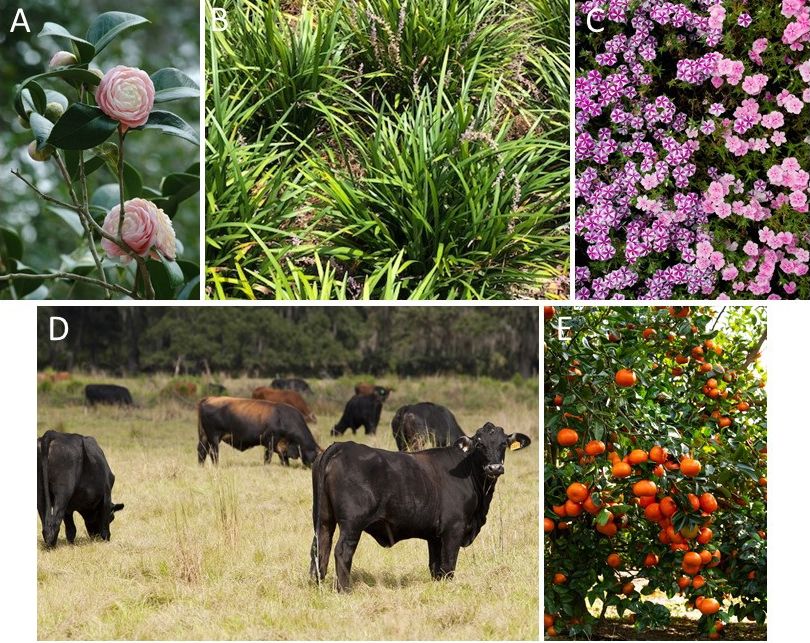
Credit: A. UF/IFAS file photo. B. Giselle Nighswander. C., D., and E. UF/IFAS file photos
“Established”
Not all introduced species expand beyond the locations into which they were introduced. However, some do and can survive and produce self-sustaining populations without human assistance. These species have therefore become “established” in a new area. As with nonnative or introduced species, established species do not necessarily cause harm. Florida has many introduced species that are now established. Some of these species include the scarlet ibis (Eudocimus ruber L.) and tokay gecko (Gekko gecko L.) (Figure 3); although the debate as to whether these species cause harm is ongoing. Note that, as with the term introduced, “established” can also apply to native species. This is because native species have self-sustaining populations in their native ranges, technically making them “established.” Nevertheless, “established” is a useful term because it can be used to indicate when an introduced species has a self-sustaining, reproducing population without human help.
The term “naturalized” indicates that a species is established, but it only applies to nonnative species. Despite being widely used in the ecological literature, many Extension professionals report stakeholders interpreting a naturalized species incorrectly as being good or part of the natural ecosystem due to the term containing the word “natural”. For this reason, the term “established” is the preferred and less confusing choice.
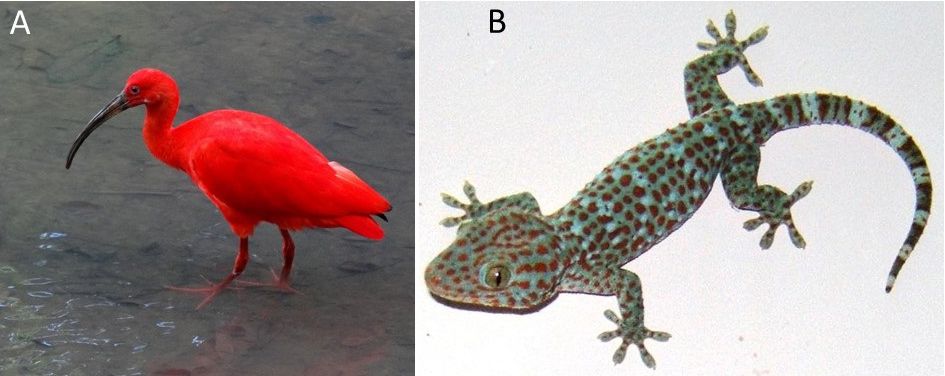
Credit: A) Bjørn Christian Tørrissen, CC BY-SA 3.0, via Wikimedia Commons. B) BacLuong at Vietnamese Wikipedia., Public domain, via Wikimedia Commons.
“Invasive”
A species classified as “invasive” meets three standardized requirements.
- The species must be nonnative to the area of consideration.
- The species must have been introduced, intentionally or unintentionally.
- The species causes, or is likely to cause, environmental harm, economic harm, and/or harm to humans.
This definition of “invasive” is the one mandated in USA Executive Order 13112 of 1999; thus, it is the definition on which US agencies rely. Because this definition of “invasive” requires harm or potential harm from a species, it provides the benefit of helping to prioritize which nonnative species to manage.
Florida is known globally as an invasive species hotspot—an area having unusually high numbers of invasive species (Dawson and others 2017). These species span multiple taxa (Figure 4). One example of an invasive species in Florida’s marine ecosystems introduced through the pet trade is the lionfish (Pterois volitans). Lionfish are native to warmer portions of the South Pacific and Indian Oceans (NOAA 2019). This species has become abundant in marine ecosystems throughout Florida and the Caribbean, where lionfish prey on native fish, compete with native fish for habitat, and even cause injuries to humans through their venomous spines (McGuire and Hill 2017). Another invasive species causing concern in urban and residential landscapes is the cane toad (Rhinella marina). This species is toxic at all life stages and poses significant risks to pets, especially dogs. Several introduced termites provide examples of invasive species that pose economic harm. There are seven different invasive termite species in Florida. These invasive insects feed on wood, causing billions of US dollars in damage annually to buildings in the United States. Regarding invasive plants, many are introduced through horticulture. An example of one such invasive plant is Brazilian peppertree (Schinus terebinthifolia). This species originates from Brazil, Argentina, and Paraguay. It now occurs in great abundance throughout central and southern Florida, causing declines in native plant and insect diversity.
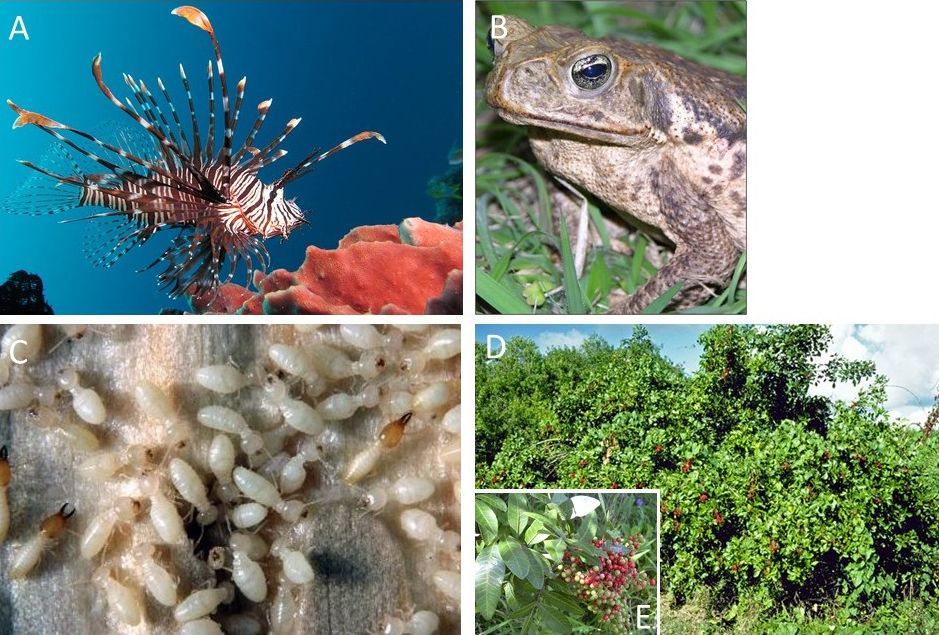
Credit: A) Alexander Vasenin, via Wikimedia Commons, B) Steven Johnson, C) Rudi Scheffrahn, D) US Army Corps of Engineers, E) Forest and Kim Starr, via Wikimedia Commons.
The impacts of nonnative species can change over time and can differ across regions, complicating the designation of a species as invasive. Regarding regions, a nonnative species may only create problems in part of its nonnative range. For instance, loquats (Eriobotrya japonica), which produce very sweet and edible fruits, are declared to be a “caution” species by the UF/IFAS Assessment of Nonnative Plants in Florida’s Natural Areas in central and south Florida, but as “not a problem species” in north Florida. This regional variability likely has to do with climatic differences, which enable loquats to become more abundant in more southern climates. Regarding time, it is not uncommon for nonnative species to become established in a given area and pose no problems, or for problems to go undetected (e.g., changes to soils) for a long time, and then suddenly the species increases in number and becomes invasive with little warning. This phenomenon can occur both for animals and plants and is referred to as “invasional lag” (Crooks 2005). While long periods until reproductive age can contribute to invasional lags (Iannone and others 2013), little is known about the factors that occur following introduction that eventually cause the species to become invasive. Regardless, the commonality of invasional lags makes it difficult to predict which established nonnative species will pose threats in the future, thereby necessitating periodic re-assessments of invasion status for established nonnative species. Finally, it requires that we educate stakeholders about invasional lags so that they understand that the invasive status of species can change.
“Nuisance”
We include the term “nuisance” because there are various situations in which individuals or groups of individuals of native species cause economic or environmental harm. Often, stakeholders incorrectly call these species “invasive” or even “native invasive.” Using these terms to describe native species is incorrect (see Table 2) and the best term for such situations is “nuisance.” The term also encapsulates other terms typically designated for specific taxa such as “weed” and “pest,” further limiting the number of terms required for invasive species education.
Under certain circumstances, individuals of certain species in Florida can become nuisances (Figure 5). One example is grape vine (Vitis spp.) (Figure 5A). Although multiple species of grapes are native to Florida, their aggressive growth can be problematic both in landscaped and natural areas. Regarding nuisance animals, in Florida these are defined by Florida Administrative Code (F.A.C.) 68A-9.10 as a native or nonnative species that “causes (or is about to cause) property damage, presents a threat to public safety, or that causes an annoyance within, under, or upon a building.” For example, alligators in public locations such as parks and golf courses can become nuisances because they can be a concern for public safety (Figure 5B). The Florida Fish and Wildlife Commission (FWC) oversees the rules and restrictions related to legislatively defined nuisance wildlife, as described on their FAQs: Nuisance Wildlife page. It is critical here to note that while a native plant in a certain area or an individual native animal may become a nuisance, this term would not apply to the entire species. All invasive species, by definition, are nuisances, but referring to them as invasive is beneficial because the term carries with it the extra information about the species being nonnative and introduced.
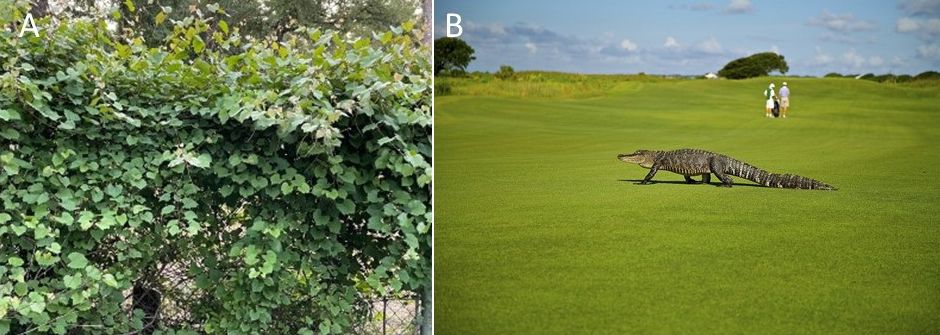
Credit: A. UF/IFAS. B. Free stock photo by Pixabay on Stockvault.net.
“Range Change”
Over time, the distribution or ranges of species can grow, shrink, and/or shift. This phenomenon is called “range change.” Both native and nonnative species can experience range changes without help from humans. Therefore, it is not correct to refer to a native species that experiences a range change as nonnative, introduced, or invasive. It is better to say that the species is experiencing a range change. There are multiple species in Florida experiencing range changes, including armadillos (Dasypus novemcinctus) and coyotes (Canis latrans) (Figure 6A–B). The ranges of both have expanded to include Florida. Another example of a set of species in Florida experiencing range changes are mangroves (Figure 6C). All three of Florida’s native mangrove species are experiencing a range change; the distributions of each are shifting north due to declines in winter freezing events (Cavanaugh and others 2014).
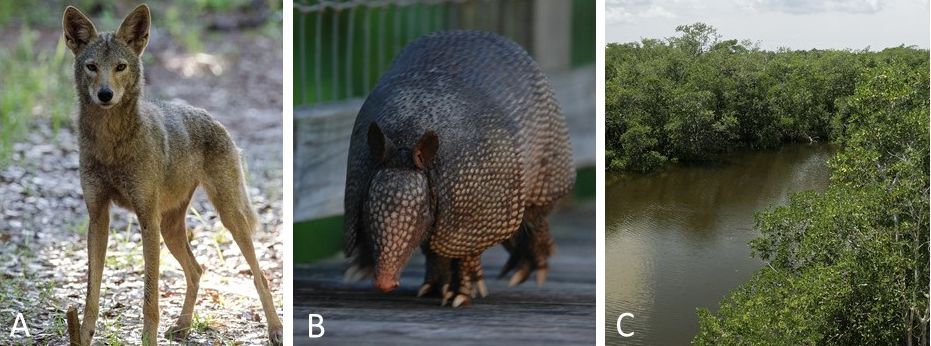
Credit: A. J. Gamble. B. and C. UF/IFAS
Terms to Avoid
Table 2 lists terms that are counterproductive to educating stakeholders about invasive species. These terms create confusion, make people think of ideas unrelated to invasive species, or are technically incorrect.
“Native Invasive”
Native species, by definition, cannot be invasive. This term typically refers to a species that, despite being native, causes management challenges. “Nuisance” is a better descriptor for the individuals of species creating these problems. The use of “native invasive” also hinders stakeholder understanding about the ultimate cause of invasive species, the continued and unchecked movement of species by humans across large geographic areas.
“Invasive Exotic”
In this phrase, the term “exotic” is synonymous with “nonnative.” Nonnative is less confusing than “exotic” because for some taxa the word “exotic” means “fancy.” Nonnative clearly signifies that a species is not from a specified geographic area. Furthermore, the term “invasive exotic” (and “invasive nonnative,” for that matter) is redundant because all invasive species are exotic/nonnative. This redundancy can create confusion and cause stakeholders to equate exotic/nonnative with invasiveness, which is inaccurate. As discussed, many exotic/nonnative species pose no threats and are therefore not invasive.
“Invasive Weed”
A weed is a plant that is simply unwanted, typically within horticultural or agricultural contexts (USDA NRCS 2018). Given that this term can refer to any plant, be it native or nonnative, this term creates confusion. Finally, we should avoid “alien,” “foreign,” and “nonindigenous” when educating stakeholders. Despite all three terms being synonymous with “nonnative,” they are often used in the context of human movement. Therefore, nonnative is a preferred term.
Table 2. Terms to avoid while educating stakeholders. From Iannone and others (2020).
Legal Definitions
Stakeholders dealing with invasive species will frequently encounter legal terms that, despite having precise definitions, are often used incorrectly. Table 3 provides definitions for more common legal terms, and lists which agencies/laws define these terms, at state and national levels. Commonly encountered legal terms include “noxious weed,” “injurious,” “prohibited,” “conditional,” and “restricted” (Table 3). Again, we provide these terms for reference. We do not recommend them for education.
“Noxious Weed”
The definition for “noxious weed” provided in Table 3 was written by the US Plant Protection Act (Public Law 106-224). The guidelines for designating plant species as noxious weeds are well-defined by USDA Animal and Plant Health Inspection Services (APHIS). The definition of “noxious weed” in use in Florida, also shown in Table 3, was written by the Florida Department of Agriculture and Consumer Services (FDACS). FDACS administers two rules related to this designation: (1) the Florida Noxious Weed List and (2) the Prohibited Aquatic Plant List. The Florida Noxious Weed List (Chapter 5B-57 of Florida Administrative Code and Florida Administrative Register) serves to augment the federal Noxious Weed list by including species that are of specific threat to Florida but not considered of national significance. FDACS also uses the term “noxious” to describe plants on the Prohibited Aquatic Plants list (Chapter 5B-64.002 of Florida Administrative Code and Florida Administrative Register). Plant species listed as “noxious weeds” by the USDA can be found on the Federal Noxious Weed List. Aquatic and terrestrial plant species listed as “noxious weeds” by FDACS can be found in Florida Administrative Code Rules 5-B-64.011 and 5B-57.007, respectively.
“Injurious” and “Prohibited”
These legal terms are typically used in the context of animals but can also be used to describe plants. The term “injurious” is defined by Merriam-Webster as “inflicting or tending to inflict injury.” This term guides government agency as to the need to regulate certain species and as to whether species are defined as “prohibited,” “conditional,” or “restricted” (see Table 3). In the United States the Lacey Act of 1900 and its subsequent amendments define the laws addressing prohibited and conditional/restricted species. Florida regulations regarding injurious species are defined in Chapter 68–5 of Florida Administrative Code and Florida Administrative Register and are administered by the FWC as stated in their Prohibited Nonnative Species List.
Stakeholders might be surprised to learn that not all invasive species are listed on injurious or noxious species lists. This is often due to groups such as UF/IFAS, FWC, or FLEPPC noting the species to be harmful prior to official legislation on those species. In addition, listing invasive species as noxious or prohibited can be somewhat difficult, due to political, economic, and research barriers.
Table 3. Legal terms commonly encountered. Provided are US and Florida laws, and/or definitions from Iannone and others (2020).
Other Resources
While the seven standardized terms we present in Table 1 largely encompass the concepts communicated by other invasive-species-related terms, some of these other terms might provide greater specificity that will be useful when educating more knowledgeable audiences. As an example, the term “adventive” can be used to describe a species that is nonnative to, and established in, a given location regardless of how it got there. Despite the apparent utility of this term, “adventive” can be confusing. It is also used to describe a species undergoing a range change and is used to describe various forms of plant growth such as adventive roots. This potential confusion can be avoided by using the standardized terminology in Table 1, i.e., by saying that the species is nonnative, established, and how it got to a location is unknown. So, an additional term is not needed. Nevertheless, definitions for other terms that may be encountered can be found in Frank (2020), Hill (2008), and Iannone and others (2020).
Conclusion
Invasive species, due to their potential to create environmental and economic harm, as well as harm to humans, present a great challenge for Florida. Given the increased mobility of humans and globalization of economies, these threats are likely to persist and increase. Incorrect and variable usage of many terms associated with invasive species limits effective education and outreach about the threat these species pose. The goal of this publication is to avoid this confusion by providing a standardized, concise set of easily defined terms that describe most situations pertaining to invasive species and that are well-suited for education of a diversity of stakeholders, regardless of their level of understanding about invasive species. In addition, we describe terms that should be avoided due to improper usage and/or misinterpretation, list common legal terms that will inevitably arise when working with stakeholders and provide additional terminology resources. We believe that the standardized terms presented here will advance invasive species education and help to increase support for invasive species-based Extension programs. Both results can lead to behavioral changes that prevent the introduction of new invasive species and lessen the impacts of those already present.
Literature Cited
Cavanaugh, K. C., J. R. Keller, A. J. Forde, D. S. Gruner, J. D. Parker, W. Rodriguez, and I. C. Feller. 2014. “Poleward Expansion of Mangroves Is a Threshold Response to Decreased Frequency of Extreme Cold Events.” Proceedings of the National Academies of Sciences 111:723–727.
Crooks, J. A. 2005. “Lag Times and Exotic Species: The Ecology and Management of Biological Invasions in Slow-Motion.” Ecoscience 12:316–329.
Dawson, W., D. Moser, M. van Kleunen, H. Kreft, J. Pergl, P. Pyšek, P. Weigelt, et al. 2017. “Global Hotspots and Correlates of Alien Species Richness across Taxonomic Groups.” Nature Ecology & Evolution 1: Article number 0186.
Frank, J. H. 2000. Glossary of Expressions in Biological Control. University of Florida, online http://ipm.ifas.ufl.edu/Education_Extension/gloss.shtml
Hill, J. E. 2008. “Non-Native Species in Aquaculture: Terminology, Potential Impacts, and the Invasion Process.” US Department of Agriculture-Southern Regional Aquaculture Center Publication No. 4303. Stoneville, Mississippi. Online publication https://srac.msstate.edu/FactSheets.html
Huang, P., and A. J. Lamm. 2016. “Identifying Invasive Species Educational Needs in Florida: Opportunities for Extension.” Journal of Extension 54:5RIB7. Available at https://tigerprints.clemson.edu/joe/vol54/iss5/11/
Iannone, B. V., III, S. Carnevale, M. B. Main, J. E. Hill, J. B. McConnell,, S. A. Johnson, S. F. Enloe, et al. 2020. “Invasive Species Terminology: Standardizing for Stakeholder Education.” Journal of Extension 58:v58–3a3. Available at: https://tigerprints.clemson.edu/joe/vol58/iss3/27/
Iannone, B. V., III, M. L. Zellner, and D. H. Wise. 2013. “Modeling the Impacts of Life-History Traits, Canopy Gaps, and Establishment Location on Woodland Shrub Invasions.” Ecological Applications 24:467–483.
MacDougall, A. 2003. Did Native Americans influence the northward migration of plants during the Holocene? Journal of Biogeography 30:633–647.
McGuire, M. and J. Hill. 2013. “Invasive Species of Florida’s Coastal Waters: The Red Lionfish (Pterois volitans) and Devil Firefish (P. miles).” SGEF 208. EDIS 2013 (11). https://doi.org/10.32473/edis-sg132-2014
NOAA (National Ocean and Atmospheric Administration). 2019. What is a lionfish? In Ocean Facts Website. Access date: 1 July 2019. https://oceanservice.noaa.gov/facts/lionfish-facts.html
USGS (US Geological Survey). 2019. USGS Gap Analysis Project Species Range and Predicted Habitat Data. Access date: 3 June 2019. https://gapanalysis.usgs.gov/apps/species-data-download
USDA NRCS (US Department of Agriculture and Natural Resources Conservation Service). 2018. Native, Invasive, and Other Plant Related Definitions. (No longer online.)